@Mr-X where can you get that ?
Posts made by Mauritio
-
RE: Bioenergetic Germanyposted in Products
What orange juice are you guys drinking ?
It seems like my beloved clementine juice isn't coming back so I'm looking for alternatives .
I've tried Amecke süsse Säfte orange today which is quite ok, but still not as good as the clementine juice. But at least drinkable to get some polyphenols etc.
I've also tried Alnatura Bio Orangensaft, which was quite bad. Immediately felt it in the sinuses. Although they normally have some decent juices like their red grape juice or the apple juice ,which seems to be high in polyphenols.
-
RE: Starch is truly slave foodposted in Literature Review
@Ismail yeah another smart move.
I think him and his son had like 10 000 children. Some ridiculous number.
Many million asians today still have Genghis Khan DNA 🧬 -
RE: Starch is truly slave foodposted in Literature Review
@Milk-Destroyer I'm convinced that Genghis khans empire was build on milk consumption.
It made them strong and flexible.
They drank a lot of horse milk, which has nutritional benefits over starch already. But not just that when other armies ran out of food during siege, they never did, because they had their horses with them. They drank their milk, ate their meat and used their dung for fire.Maybe the empire collapsed when they stoped being nomadic, built cities and stopped consuming as much milk.
"...between 30 percent and 50 percent of their summertime dietary calories come from dairy products. These range from mare’s milk (men will consume up to eight liters of fermented airag a day), to lightweight, calorie-dense curds that can be transported and stored for up to two years—in all, more than 20 different dairy-based foods. "
https://www.harvardmagazine.com/2020/08/right-now-did-milk-build-mongol-empire
-
RE: Studies showing cancer reversal / shrinkingposted in Bioenergetics Discussion
@cs3000 said in 2 studies showing cancer reversal / shrinking:
@cs3000 said in 2 studies showing cancer reversal / shrinking:
@Mauritio yep and i imagine daily would be even better, interesting that short duration was effective it does work broadly yeah
here it had less profound effect in a connective tissue cancer but still good
https://www.ncbi.nlm.nih.gov/pmc/articles/PMC3499556/#s2title they did 10 minutes instead of 20 minutes .
I just saw something amazing actually when they tested it on breast cancer in vivo it almost didnt grow at all :Here we go, big one
https://www.spandidos-publications.com/10.3892/or.2017.5591
great studies by these people exploring all the anglesSurprisingly going for more days of co2 weekly didnt give better effect, 2 days is enough,
but going for longer than 10 minutes does give more improvement (20 minutes worked better) in breast & bone cancer, effect peaks around there as 1 hr did not give better effect- Additionally, in a preliminary study, no further decrease in tumor volume was observed with the 1-h treatment compared to the 20-min treatment
- For the CO2 therapy, there was no difference in effectiveness of frequencies of twice and five times per week; in addition, a twice-weekly treatment regimen was sufficient to inhibit in vivo tumor growth, even in MFH/UPS, which is a high-grade sarcoma cell line.
And they found the cancer regressed below baseline with 20 minutes applications, in all of the mice
And they even said two of the breast cancer tumors disappeared @haidut
Bone tumors also got smaller below baseline
.... this is happening fast over a few days / weeks ... amazingit did not work as well on a rarer aggressive sarcoma tumor. but slowed growth with this (which the table doesnt show)
-
in addition, a twice-weekly treatment regimen was sufficient to inhibit in vivo tumor growth, even in MFH/UPS, which is a high-grade sarcoma cell line.
-
In the current study, the most significant antitumor effect was observed in the MDA-MB-231 breast cancer model. At the end of treatment, all treated tumors in the MDA-MB-231 model were smaller than pre-treated tumors, and notably, two of the six tumors in the 20-min group had disappeared
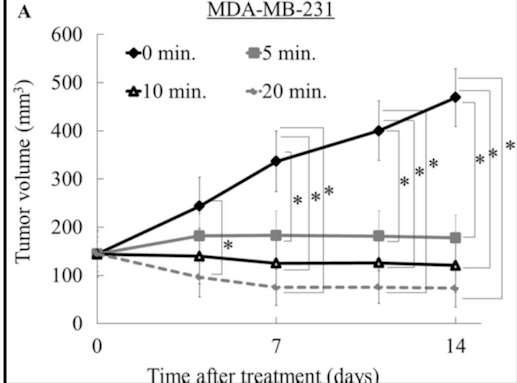

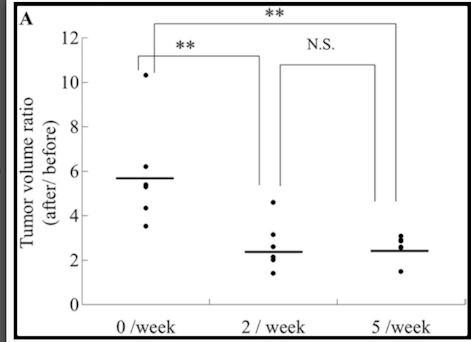
Additionally, using a treatment frequency of twice per week, tumor volumes were smaller with a treatment interval of 3 and 4 days than with a treatment interval of 2 and 5 days.
We also found that transcutaneous CO2 application was ineffective when applied at a distant site relative to the tumor location. Therefore, the CO2 therapy should be applied to the body surface close to the tumor location.
We previously developed an alternative system for CO2 application that can access deep-seated tumors using intra-arterial infusion of saturated CO2 solution (20). These findings suggest that continuous treatment, twice per week with an interval of 3 + 4 days, applied to the local site of the tumor, provides the best antitumor effect for transcutaneous CO2 application.So 20 minutes, enhanced by a co2 capturing gel locally to the tumor site, 2 times per week, every wednesday and sunday (3 & then 4 days), gives max effectiveness
sounds like simple glycerol/glycerin + water could work for the gel,
or sodium alginate
(majority water as long as its thick enough to not run down skin)
https://patents.google.com/patent/JPWO2004002393A1/en?oq=WO2004%2F002393-
A viscous liquid prepared using 2 parts by weight of sodium alginate as a thickener and 98 parts by weight of purified water as water is impregnated into a 4 cm diameter polyester nonwoven fabric, and this is immersed in a 1% calcium chloride aqueous solution to support the nonwoven fabric. A hydrogel film of calcium alginate as a body was prepared, and this was adopted as a carbon dioxide absorption aid 4
-
An appropriate amount of the carbon dioxide absorption assisting material 4 is applied to a 5 mm diameter scratch on the left back of a 37-year-old woman, a left hand is put in the sealed envelope 2, and carbon dioxide is supplied to the sealed envelope 2 by the carbon dioxide supply device 3 to 10 seconds at a rate of 200 milliliters / second, and then 5 minutes at a rate of 20 milliliters / second. When the auxiliary material was washed away, the pain felt before touching the water completely disappeared, and the wound healing promoting effect was confirmed.
-
A 48-year-old man's 5cm square carbon dioxide absorption aid 4 is affixed to the left back of the 48-year-old man, and without putting anything on the right back, each hand is put in the two sealed enclosures 2a and 2b, and each enclosed enclosure Carbon dioxide was first supplied to the material 2 from the carbon dioxide supply device 3 at a rate of 200 milliliters / second for 10 seconds and then at a rate of 20 milliliters / second for 7 minutes.
The man's hands quickly became warm, but the left back felt warmer than the right back.
Gel + ~ 7 Liters of co2 gas sealed in a 20cm long plastic bag was enough for pain reduction and wound healing effect in this woman
I am going through the studies that this Takeshi guy did and there's some interesting ones. Not sure if that one has been shared.
CO2 therapy was just as effective as radiation therapy for this oral squamous cell carcinoma.
But CO2 and radiation combined was a lot more effective. And I suppose CO2 made the radiation a lot safer, as can be seen by the rescued white blood cell count.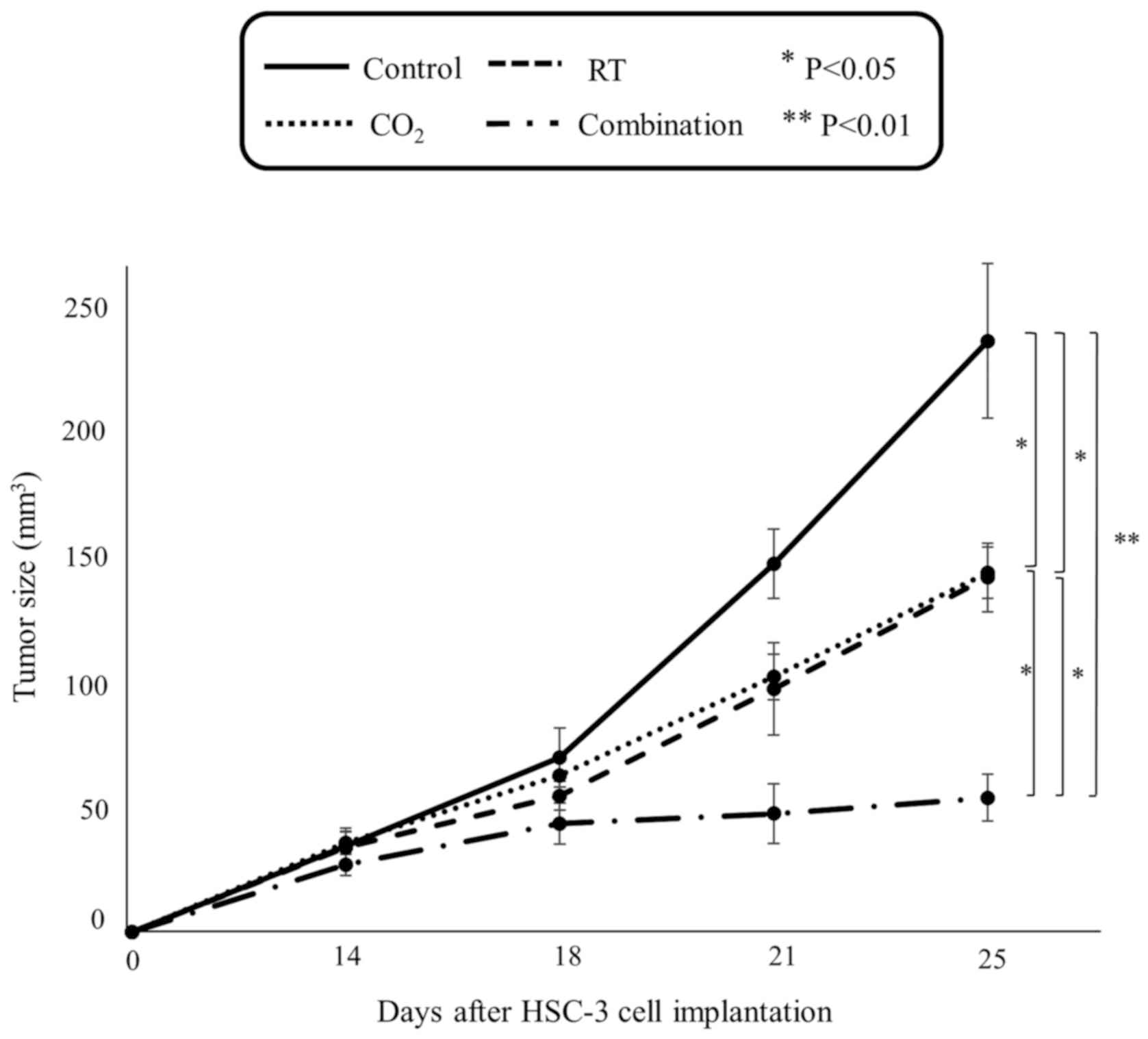
-
RE: Methionine/Cysteine restriction increases longetivity AND energy expenditureposted in Literature Review
@Ecstatic_Hamster I think it's mostly selenomethionine.
-
RE: Methionine/Cysteine restriction increases longetivity AND energy expenditureposted in Literature Review
Haa anybody tried sodium selenite and selenomethionine and can compare them ?
According to the study I posted sodium selenite should be quite a bit more effective than selenomethionine.
-
RE: Methionine/Cysteine restriction increases longetivity AND energy expenditureposted in Literature Review
@cs3000
T3's FGF21 increase depends on PPARa, so we got another player in the game.This is what Travis wrote on the PPARs:
"The activation of the PPAR receptors can be considered a good thing, and their first described function was to upregulate peroxisomes—small subcellular organelles which metabolize excessive prostaglandins and fats. I get the impression that the activation of these could represent the 'resolution stage' of inflammation—an idea which may depend on exactly which subtype of PPAR is activated. I am aware of four types: PPARα, PPARβ, PPARγ, and PPARδ. Of these four, PPARγ get the most attention . . . by far."
-
RE: Rapamycin: Anti-aging and metabolic dream drug?posted in Bioenergetics Discussion
@cs3000 yeah. And combining acetazolamide with CO2 baths might make the combo even more effective. I remember the impressive studies you posted on CO2 baths for cancer where the tumor shrunk significantly. Adding acetazolamide should help you retain the added CO2 longer.
-
RE: Rapamycin: Anti-aging and metabolic dream drug?posted in Bioenergetics Discussion
@cs3000 that is interesting. If acetazolamide can more or less substitute for MR in this scenario then that probably means MR's benefits in terms of cancer rely on CO2 increase as almost everything acetazolamide does is downstream from an increase in CO2.
On the other hand tumors have something called "methionine addiction" also called the Hoffman effect, so that might play a role as well.
"This phenomenon describes the inability of cancer cells to proliferate when methionine is replaced with its metabolic precursor, homocysteine, while proliferation of non-tumor cells is unaffected by these conditions. "
https://www.ncbi.nlm.nih.gov/pmc/articles/PMC7226524/ -
RE: Rapamycin: Anti-aging and metabolic dream drug?posted in Bioenergetics Discussion
This is the type of study I want to see.
The combination of rapamycin and methioniase eradicated osteosarcoma.
The interesting part is that rapamycin or methioniase alone were not able to do that.
You can see on the chart that rapamycin was somewhat effective at slowing tumor growth, but it still grew.When rapa and methioniase were combined the tumor didn't even start to grow, it even decreased in size.
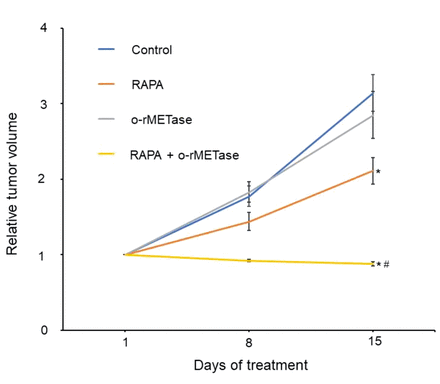
The implication here is that a low methionine diet and rapamycin are syngergistic.
We can replace methioniase with a low protein diet, since they both have the same outcome.Obviously this is relevant for cancer patients, but since cancer is just a deranged metabolism this is relevant to all other issues of metabolism. Meaning even if you're on a low protein diet you might benefit from rapamycin and even if you're on rapamycin, you might still benefit from a low protein diet.
@evan-hinkle i think you tried both, did you notice any commonalities or added benefits between rapa and MR ?
-
RE: Rapamycin: Anti-aging and metabolic dream drug?posted in Bioenergetics Discussion
Surprisingly this review argued that quinones would increase mTOR.
Because quinones increase Nrf2 which in turn increases mTOR.What should we think of that ?
In theory that would cause a pro-cancer effect, but quinones do lot more than activating Nrf2 ... -
RE: Rapamycin: Anti-aging and metabolic dream drug?posted in Bioenergetics Discussion
Hey! Great points.
It's interesting that you came to the same conclusions as I have.
-
Selenium can partially replicate MR benefits. Especially sodium selenite.
-
A certain part of MRs benefits are due to inhibition of mTOR, although not all.
This is where rapamycin comes into play.
So far I haven't found anything that completely substitutes for going on a low protein diet.
- A low protein diet should be very helpful against cancer.
And that is why Koch's "vegan" diet worked, because it was low protein. He was so much ahead of his time .
None of the 40% life span increase studies or anti-cancer studies on MR had been done during his life time. Yet he figured it out.
And let's not forget that he figured out that quinones are good for cancer as well. Legend.
That makes me wonder how quinones affect protein restriction, methionine or mTOR. Maybe there's a connection, too.For all of these points I posted studies in this thread:
-
-
RE: moderate protein restriction can cure all illsposted in Literature Review
I'm thinking about a modified version of protein restriction ATM.
If you'd have most of your protein at a certain point in time if the day , you'd get a big part of the MR/PR benefits.
In animals beneficial metabolic changes like an increase in FGF21 started showing after only 6h of the diet.
So if you eat a significant amount of protein only once a day, you get an 18h window of the benefits.I thinks that's a reason why (intermittent) fasting works to some degree: You're restricting protein.
-
RE: moderate protein restriction can cure all illsposted in Literature Review
@Ecstatic_Hamster
Great study! Thanks for sharing.Here's an important part of the study:
Energy expenditure decreased in CR by about 6%, while it didn't in PR.
In CR, VO2 and VCO2 , respiratory quotient,
and carb oxidation decreased (-77%!) while it didn't decrease in PR.
That is all in line with what I saw in previous studies.
PR for the win.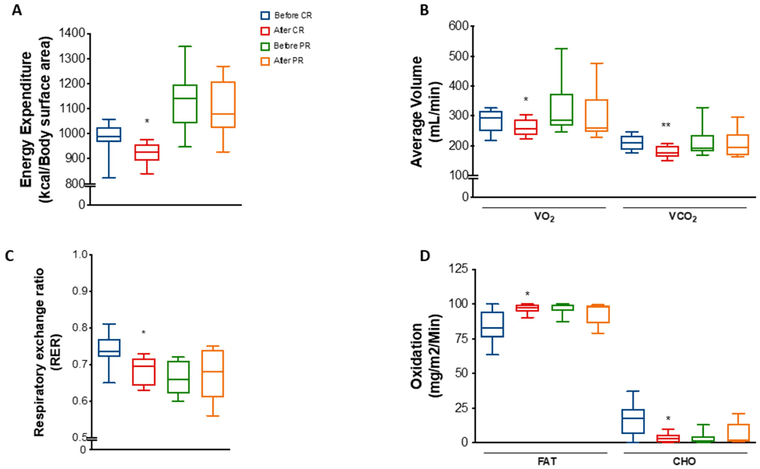
-
RE: Methionine/Cysteine restriction increases longetivity AND energy expenditureposted in Literature Review
Peat says in this interview a 7:1 ratio of carbs to protein can often be "very energizing" and that once people reach adulthood they likely consume too much protein.
He also says the feels like this ratio has increased his sensitivity to thyroid.https://oneradionetwork.com/dr-ray-peat-your-health-questions-answered-june-20-2022/
-
RE: Danny Roddy on "avoid liquid thyroid"posted in Bioenergetics Discussion
@Kvothe it feels more natural and hormonal for a lack of better words. Feels a little like pregnenolone as well. Metabolism is definitely increased , sleep time/need decreased. First day temp went to 37 degrees after food ,which wasn't the case for a long time before...
-
RE: Methionine/Cysteine restriction increases longetivity AND energy expenditureposted in Literature Review
@DavidPS said in Methionine/Cysteine restriction increases longetivity AND energy expenditure:
@Ecstatic_Hamster -I also prefer to use collagen rather than glycine.
Critics of collagen have for years argued that, if you ingest protein from an egg or piece of beef, digestive enzymes will break the protein down into single amino acids and that collagen is therefore no different than any other protein. However, recent evidence indicates that humans lack the enzymes to break down selected amino acid sequences unique to collagen. These are sequences such as Gly-Pro-Hyp (Glycine-Proline-Hydroxyproline) and related dipeptide sequences (e.g., Gly-Pro, Pro-Hyp, Gly-Hyp). These di and tripeptides then make their way intact to joint cartilage, arteries, skin and elsewhere and exert their beneficial effects, such as promoting local production of more collagen.
In other words, ingesting collagen does not cause deposition of the ingested collagen in various organs.
Not just that . Collagen also has its own pro-metabolic, anti-inflammatory peptides that are lost when only consuming glycine.
-
RE: Methionine/Cysteine restriction increases longetivity AND energy expenditureposted in Literature Review
@VehmicJuryman said in Methionine/Cysteine restriction increases longetivity AND energy expenditure:
@Mauritio said in Methionine/Cysteine restriction increases longetivity AND energy expenditure:
i think it makes sense to look into the differing methionine and cysteine contens of foods.
For example milk and milk products have a lot less of those amino acids than meat. So you can eat a higher amount of cheese, yoghurt or milk, as compared to meat.
But even amongst cheeses there is a big difference in methionine content. Parmesan for example is very high.
For example : if you ate cheddar or mozzarella cheese instead of parmesan you could eat almost twice as much and still get the same amount of methionine.
If you ate feta you could eat almost 3 times the amount comapred to parmesan.
And if you eat cottage cheese you could eat almost 4 times as much.So if you eat the right type of protein like milk and find a low methionine cheese you can make your life a lot easier while still eating resting methionine.
Another good food is, Cocoa/ Chocolate. It's low in methionine, moderately high in cysteine and low in tryptophan. I think it is also a high quality protein for anabolism, haidut posted a study on that IIRC
Heres a good list:
https://fitaudit.com/categories/mlk/methionineEgg yolks seem to be a lot lower in methionine than whites, another reason to discard the whites:
https://fitaudit.com/categories/egg/methionineThis site even shows the cysteine content:
https://cystinuria.org/methionine-levels/Milk and dairy products actually have more methionine than glycine, unlike meat which has more glycine than methionine. Dairy products have the highest methionine to glycine ratio of any food.
The ratio is less important than the absolute content. And meat has way, more methionine and Cysteine than milk.
Plus, glycine is easy to supplement, so milk + added glycine is a really good food in terms of MR.
-
RE: Danny Roddy on "avoid liquid thyroid"posted in Bioenergetics Discussion
@Kvothe said in Danny Roddy on "avoid liquid thyroid":
@Mauritio I think because of the SFA esters in Georgi's product it's best to always use >99% alcohol for dilution. When I used lower percentages little fatty droplets would remain. Mixing it with 99,5% ethanol I haven't experienced any consistency issues, I believe.
Interesting. I do experience issues using 96.5% alcohol. Less than with gin, but I still feel like during the last part of the bottle I become slightly but increasingly more hypo.
I started using hilma biocare T3 recently and it feels very different and I have no idea why. They are the same molecules so they shouldn't feel different. I sent some to @Mr-X and I think he also has a very different reaction than to other T3 products . Not sure what's going on here ...